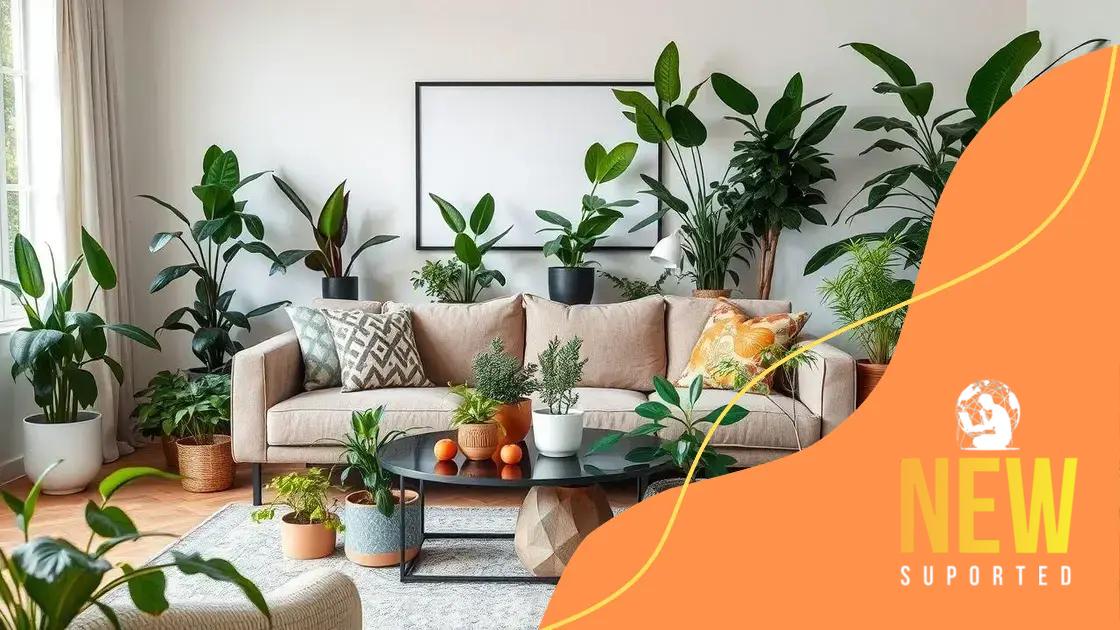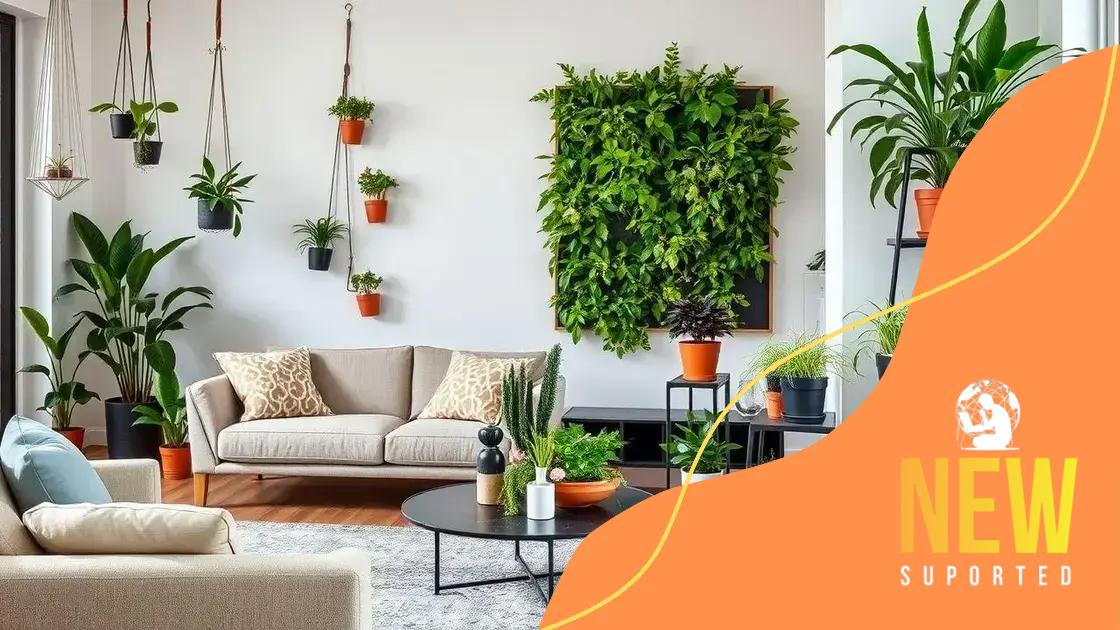How to decorate your home with indoor plants

To effectively decorate your home with indoor plants, choose the right plants for your light conditions, display them creatively, and ensure proper care through watering, fertilizing, and DIY projects like terrariums.
How to decorate your home with indoor plants is not just about beauty; it’s about enhancing your mood and creativity. Ever thought about how a simple plant can change your space?
Selecting the right indoor plants
Choosing the right indoor plants is essential for transforming your space. It’s important to consider factors like lighting and the climate of your home. From beautiful succulents to lush ferns, there’s a plant for every room.
Assessing Your Space
Take a look at your home. Do you have bright sunny areas or cozy, shaded spots? Understanding your home’s lighting is key to selecting the right plants. Some plants thrive in bright light, while others prefer lower light conditions.
Types of Indoor Plants to Consider
- Succulents: Great for sunny spots and easy to care for.
- Ferns: Perfect for low-light areas and add a touch of greenery.
- Snake Plants: Tolerant of neglect, ideal for beginners.
- Pothos: Fast-growing and adaptable to various conditions.
Once you’ve identified the lighting in your home, it’s time to select the plants. Remember, each plant has specific needs. Consider how often you can water and maintain them. Some plants require frequent watering, while others thrive on minimal care.
Considering Plant Placement
Placement matters just as much as selection. For example, placing plants near windows can help them receive the light they need. However, some plants may need to be kept away from drafts or direct sunlight. Think about your room’s layout and choose locations that enhance the plants’ health.
As you embark on this journey of decorating with indoor plants, think about how each plant contributes to your home’s overall atmosphere. A well-placed plant can not only beautify a space but also improve the air quality. Enjoy the process of creating your green oasis!
Best indoor plants for various lighting conditions
Choosing the best indoor plants for your home can be a fun and rewarding experience. It’s essential to match plants to the specific lighting conditions of your space to ensure they thrive. Different plants have different needs, and understanding these can help you create a vibrant environment.
Low Light Plants
If your home has limited natural light, consider plants that can flourish in these conditions. Pothos is a fantastic choice, as it grows well even in shadows. Snake plants are also excellent, requiring minimal care and tolerating neglect. Additionally, ZZ plants are perfect for dark corners, as they can survive on little light.
Bright, Indirect Light Plants
For areas with bright, but indirect sunlight, you have a wider selection. Spider plants thrive in these conditions and are very forgiving if you forget to water them occasionally. Peace lilies not only love bright spaces but also bloom beautiful white flowers, adding a touch of elegance. Dracaena is another great option that brings height and bold foliage to your decor.
Direct Light Plants
If you have sunny spots in your home, some plants thrive on direct light. Succulents and cacti are ideal choices, as they love soaking up the sun’s rays. Fiddle leaf figs require plenty of sunlight to grow strong and tall, making them a statement piece in any room. Another vibrant option is lemon trees, which not only provide color but also fresh, fragrant fruits.
As you explore plant options, remember to assess the light in each room carefully. This simple step can make a world of difference in your indoor garden’s success. By selecting the appropriate indoor plants for your lighting conditions, you’ll enjoy a lush and lively home!
Creative ways to display indoor plants

Displaying your indoor plants in creative ways can truly enhance your home’s ambiance. With a little imagination, you can transform ordinary spaces into a vibrant, green oasis. Consider using various materials and methods to make your plants stand out.
Utilizing Unique Planters
Start by selecting unique planters that reflect your style. Instead of traditional pots, try using vintage teacups or colorful baskets. Hanging planters made of macrame add a bohemian touch, while geometric terrariums can introduce a modern flair.
Vertical Gardens
A vertical garden is a fantastic way to save space while showcasing multiple plants. You can use wall-mounted shelves or a trellis to create your garden. This technique allows you to arrange your plants in an artistic way, drawing the eye upward and making any room feel larger.
- Wall-mounted shelves: Ideal for small spaces and can be customized with various plants.
- Living walls: Use a frame filled with soil and plants, creating a stunning focal point.
- Hanging planters: Suspend plants from the ceiling or wall to add depth.
In addition to these displays, consider utilizing bookshelves or unused corners to add greenery. Place trailing plants like Pothos or String of Hearts on shelves so they can dangle elegantly. This not only enhances the shelf but also helps in purifying the air.
Plant Stands and Arrangements
Using plant stands can elevate your plants and create visual interest. Consider a tiered plant stand that allows various heights, showcasing different types of plants together. Group plants by size or color to create stunning arrangements, adding depth and texture. Mixing leafy varieties with flowering plants adds variety and natural beauty.
Creative plant displays not only beautify your home but also bring life into your space. Experiment with different styles and arrangements to discover what feels right for you. With creativity, you can make your indoor plants the stars of your home!
Caring for your indoor plants
Caring for your indoor plants is essential to ensure they remain healthy and vibrant. Each plant has its own needs, so understanding some basic care tips will help you thrive in your indoor gardening journey. Regular watering, proper lighting, and humidity control are key factors to keep your plants happy.
Watering Guidelines
Watering is vital for all plants, but it’s important to know how much and how often to water. Overwatering can lead to root rot, while underwatering can cause plants to wilt. A good rule of thumb is to check the top inch of the soil: if it feels dry, it’s time to water. Some plants, like succulents, prefer less water, while tropical plants may need a bit more.
Understanding Light Requirements
Each indoor plant has its light preferences. When caring for your plants, make sure they are placed in optimal lighting conditions. Bright, indirect light suits many houseplants, while succulents tend to thrive in direct light. As seasons change, so do light levels. Monitor your plants and adjust their placement accordingly.
- Rotate your plants: This ensures even growth, as they will all receive light from different angles.
- Use sheer curtains: If your plant needs bright light but you have harsh sunlight, filter it with curtains.
- Monitor signs: If leaves become pale, they might need more light, while scorched edges indicate too much sun.
Proper humidity is also crucial for many indoor plants. If your home is dry, consider using a humidifier or placing a tray of water with pebbles under your pots. This can help provide the moisture that plants like ferns and palms need to thrive.
Fertilizing and Pruning
Fertilizing your plants can provide them with the nutrients they need to grow strong. Most indoor plants benefit from a balanced fertilizer during their growing season, which is typically spring and summer. Follow the instructions on the fertilizer package to avoid over-fertilizing, which can damage your plants.
Pruning is also a crucial part of plant care. Removing dead or yellowing leaves helps prevent disease and encourages healthy growth. Regularly check your plants and trim them as needed. With the right care, your indoor garden will flourish and bring joy to your home!
Bringing nature indoors with DIY plant projects
Bringing nature indoors can be a fun and creative process, especially through DIY plant projects. These projects not only enhance your home with greenery but also provide a wonderful opportunity for personal expression. Whether you are new to gardening or just enjoy crafting, there are numerous ways to incorporate plants into your decor.
Creating Your Own Planters
One great way to start is by making your own planters. You can use various materials such as wood, terracotta, or even recycled items like tin cans and glass jars. Customizing these planters allows you to express your creativity while giving your plants a beautiful home.
- Painted Terracotta Pots: Give ordinary pots a splash of color with acrylic paint. Use stencils for fun designs!
- Hanging Baskets: Create hanging planters from macrame or old fabric. These can be suspended from the ceiling, saving space.
- Repurposed Containers: Look around your home for unique containers. Old cups, bowls, or even crates can make charming planters.
After you have your personalized planters ready, choose the right plants that fit each type. For instance, succulents thrive in smaller, drained pots, while trailing plants look lovely in hanging containers.
Building a Vertical Garden
Another exciting DIY project is constructing a vertical garden. This approach not only saves space but also creates a striking focal point in your home. You can use wooden pallets, trellises, or a simple frame to hold your plants in a vertical arrangement.
Start by gathering materials, then attach planters or pots to your chosen structure. Fill them with climbing plants like ivy or herbs like basil. This not only looks beautiful but can also provide fresh herbs for your kitchen!
For added interest, mix different plant types, combining various colors and textures. A well-designed vertical garden can breathe life into any empty wall.
DIY Terrariums
Terrariums are another fantastic way to bring nature inside. They are low-maintenance and add an enchanting element to your decor. To create a terrarium, select a clear glass container, layer the bottom with pebbles for drainage, add activated charcoal to keep things fresh, and finish with potting soil. Choose small plants, fit for the size of your container, and place them inside.
Consider adding decorative elements, such as small figurines or colored stones, for a personal touch. These tiny ecosystems are not only a conversation starter but also a delight to care for.
Through these DIY plant projects, you can transform your home into a lush retreat filled with creativity and nature’s beauty. Let your imagination guide you as you explore different ways to integrate plants into your living space!
In conclusion, decorating your home with indoor plants is a wonderful way to bring nature inside. By selecting the right plants for your space, creatively displaying them, and caring for them properly, you can create a beautiful and inviting environment. DIY plant projects allow you to personalize your decor while enjoying the benefits of greenery. Remember that every plant has its own needs, so take the time to learn and nurture them. With a bit of effort and creativity, your home can become a vibrant oasis!
FAQ – Indoor Plants and Home Decoration
What are the best indoor plants for beginners?
Some great indoor plants for beginners include pothos, snake plants, and peace lilies, as they are low-maintenance and thrive in various conditions.
How often should I water my indoor plants?
Watering frequency depends on the plant, but a good rule is to check the top inch of soil; if it’s dry, it’s time to water.
Can I use recycled materials for plant projects?
Absolutely! Items like old jars, tin cans, and pallets can be creatively repurposed as unique planters and garden structures.
What are some DIY projects for indoor plants?
Popular DIY projects include creating painted planters, building vertical gardens, and assembling terrariums to bring nature indoors.






